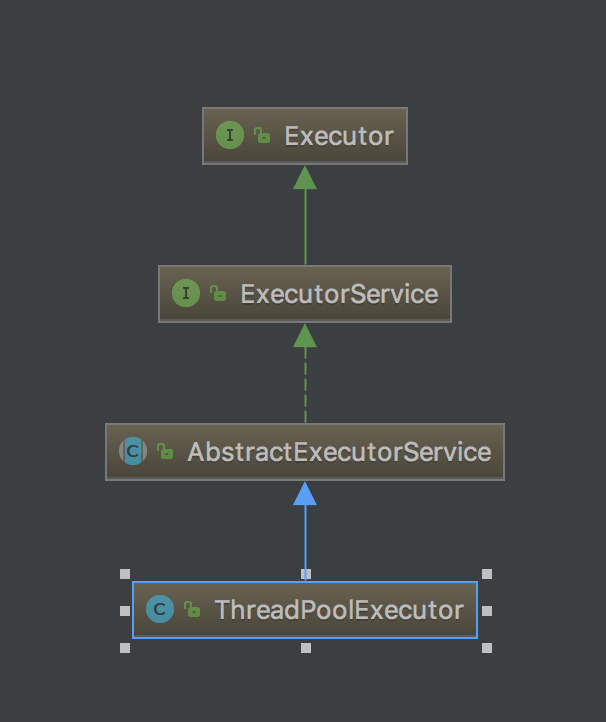ThreadPoolExecutor类
ThreadPoolExecutor类
1. ThreadPoolExecutor类构造器
java.uitl.concurrent.ThreadPoolExecutor类是线程池中最核心的一个类,因此如果要透彻了解Java中线程池,就需要先了解这个类。下面我们来看一ThreadPoolExecutor类的具体实现源码
在ThreadPoolExecutor类中提供了四个构造方法:

public class ThreadPoolExecutor extends AbstractExecutorService {
// 第一个构造器
public ThreadPoolExecutor(int corePoolSize,
int maximumPoolSize,
long keepAliveTime,
TimeUnit unit,
BlockingQueue<Runnable> workQueue) {
this(corePoolSize, maximumPoolSize, keepAliveTime, unit, workQueue,
Executors.defaultThreadFactory(), defaultHandler);
}
// 第二个构造器
public ThreadPoolExecutor(int corePoolSize,
int maximumPoolSize,
long keepAliveTime,
TimeUnit unit,
BlockingQueue<Runnable> workQueue,
ThreadFactory threadFactory) {
this(corePoolSize, maximumPoolSize, keepAliveTime, unit, workQueue,
threadFactory, defaultHandler);
}
// 第三个构造器
public ThreadPoolExecutor(int corePoolSize,
int maximumPoolSize,
long keepAliveTime,
TimeUnit unit,
BlockingQueue<Runnable> workQueue,
RejectedExecutionHandler handler) {
this(corePoolSize, maximumPoolSize, keepAliveTime, unit, workQueue,
Executors.defaultThreadFactory(), handler);
}
// 第四个构造器
public ThreadPoolExecutor(int corePoolSize,
int maximumPoolSize,
long keepAliveTime,
TimeUnit unit,
BlockingQueue<Runnable> workQueue,
ThreadFactory threadFactory,
RejectedExecutionHandler handler) {
if (corePoolSize < 0 ||
maximumPoolSize <= 0 ||
maximumPoolSize < corePoolSize ||
keepAliveTime < 0)
throw new IllegalArgumentException();
if (workQueue == null || threadFactory == null || handler == null)
throw new NullPointerException();
this.corePoolSize = corePoolSize;
this.maximumPoolSize = maximumPoolSize;
this.workQueue = workQueue;
this.keepAliveTime = unit.toNanos(keepAliveTime);
this.threadFactory = threadFactory;
this.handler = handler;
}
}
从上面的代码可以得知,ThreadPoolExecutor继承了AbstractExecutorService类,并提供了四个构造器,事实上,通过观察每个构造器的源码具体实现,发现前面三个构造器都是调用的第四个构造器进行的初始化工作。
2. 构造器参数含义
2.1 corePoolSize:核心池的大小
corePoolSize:核心池的大小
在创建了线程池后,默认情况下,线程池中并没有任何线程,而是等待有任务到来才创建线程去执行任务。当线程池中的线程数目达到corePoolSize后,就会把到达的任务放到缓存队列当中;
除非调用了prestartAllCoreThreads()或者prestartCoreThread()方法预创建线程。即在没有任务到来之前就创建corePoolSize个线程或者一个线程
2.2 maximumPoolSize:线程池最大线程数
maximumPoolSize:线程池最大线程数,这个参数也是一个非常重要的参数,它表示在线程池中最多能创建多少个线程;
2.3 keepAliveTime:线程没有任务执行时最多保持多久时间会终止
keepAliveTime:表示线程没有任务执行时最多保持多久时间会终止。
- 默认情况下,只有当线程池中的线程数大于corePoolSize时,keepAliveTime才会起作用,直到线程池中的线程数不大于corePoolSize
- 即当线程池中的线程数大于corePoolSize时,如果一个线程空闲的时间达到keepAliveTime,则会终止,直到线程池中的线程数不超过corePoolSize
- 但是如果调用了allowCoreThreadTimeOut(boolean)方法,在线程池中的线程数不大于corePoolSize时,keepAliveTime参数也会起作用,直到线程池中的线程数为0;
2.4 unit:参数keepAliveTime的时间单位
unit:参数keepAliveTime的时间单位,有7种取值,在TimeUnit类中有7种静态属性:
TimeUnit.DAYS; //天
TimeUnit.HOURS; //小时
TimeUnit.MINUTES; //分钟
TimeUnit.SECONDS; //秒
TimeUnit.MILLISECONDS; //毫秒
TimeUnit.MICROSECONDS; //微妙
TimeUnit.NANOSECONDS; //纳秒
2.5 workQueue: 阻塞队列
workQueue:一个阻塞队列,用来存储等待执行的任务,这个参数的选择也很重要,会对线程池的运行过程产生重大影响,一般来说,这里的阻塞队列有以下几种选择:
ArrayBlockingQueue;
LinkedBlockingQueue;
SynchronousQueue;
ArrayBlockingQueue和PriorityBlockingQueue使用较少,一般使用LinkedBlockingQueue和Synchronous。线程池的排队策略与BlockingQueue有关。
2.6 threadFactory: 线程工厂
threadFactory:线程工厂,主要用来创建线程;
2.7 handler:拒绝处理任务时的策略
handler:表示当拒绝处理任务时的策略,有以下四种取值:
ThreadPoolExecutor.AbortPolicy:丢弃任务并抛出RejectedExecutionException异常。
ThreadPoolExecutor.DiscardPolicy:也是丢弃任务,但是不抛出异常。
ThreadPoolExecutor.DiscardOldestPolicy:丢弃队列最前面的任务,然后重新尝试执行任务(重复此过程)
ThreadPoolExecutor.CallerRunsPolicy:由调用线程处理该任务
3. ThreadPoolExecutor的继承关系
从上面给出的ThreadPoolExecutor类的代码可以知道,ThreadPoolExecutor继承了AbstractExecutorService,我们来看一下AbstractExecutorService的实现:
public abstract class AbstractExecutorService implements ExecutorService {
protected <T> RunnableFuture<T> newTaskFor(Runnable runnable, T value) { };
protected <T> RunnableFuture<T> newTaskFor(Callable<T> callable) { };
public Future<?> submit(Runnable task) {};
public <T> Future<T> submit(Runnable task, T result) { };
public <T> Future<T> submit(Callable<T> task) { };
private <T> T doInvokeAny(Collection<? extends Callable<T>> tasks,
boolean timed, long nanos)
throws InterruptedException, ExecutionException, TimeoutException {
};
public <T> T invokeAny(Collection<? extends Callable<T>> tasks)
throws InterruptedException, ExecutionException {
};
public <T> T invokeAny(Collection<? extends Callable<T>> tasks,
long timeout, TimeUnit unit)
throws InterruptedException, ExecutionException, TimeoutException {
};
public <T> List<Future<T>> invokeAll(Collection<? extends Callable<T>> tasks)
throws InterruptedException {
};
public <T> List<Future<T>> invokeAll(Collection<? extends Callable<T>> tasks,
long timeout, TimeUnit unit)
throws InterruptedException {
};
}
AbstractExecutorService是一个抽象类,它实现了ExecutorService接口。
我们接着看ExecutorService接口的实现:
public interface ExecutorService extends Executor {
void shutdown();
boolean isShutdown();
boolean isTerminated();
boolean awaitTermination(long timeout, TimeUnit unit)
throws InterruptedException;
<T> Future<T> submit(Callable<T> task);
<T> Future<T> submit(Runnable task, T result);
Future<?> submit(Runnable task);
<T> List<Future<T>> invokeAll(Collection<? extends Callable<T>> tasks)
throws InterruptedException;
<T> List<Future<T>> invokeAll(Collection<? extends Callable<T>> tasks,
long timeout, TimeUnit unit)
throws InterruptedException;
<T> T invokeAny(Collection<? extends Callable<T>> tasks)
throws InterruptedException, ExecutionException;
<T> T invokeAny(Collection<? extends Callable<T>> tasks,
long timeout, TimeUnit unit)
throws InterruptedException, ExecutionException, TimeoutException;
}
而ExecutorService又是继承了Executor接口,我们看一下Executor接口的实现:
public interface Executor {
void execute(Runnable command);
}
到这里,大家应该明白了ThreadPoolExecutor、AbstractExecutorService、ExecutorService和Executor几个之间的关系了。

Executor是一个顶层接口,在它里面只声明了一个方法execute(Runnable),返回值为void,参数为Runnable类型,从字面意思可以理解,就是用来执行传进去的任务的;
然后ExecutorService接口继承了Executor接口,并声明了一些方法:submit、invokeAll、invokeAny以及shutDown等;
抽象类AbstractExecutorService实现了ExecutorService接口,基本实现了ExecutorService中声明的所有方法;
然后ThreadPoolExecutor继承了类AbstractExecutorService。
4. 在ThreadPoolExecutor类中有几个非常重要的方法:
4.1 execute()方法
execute()方法实际上是Executor中声明的方法,在ThreadPoolExecutor进行了具体的实现,这个方法是ThreadPoolExecutor的核心方法,通过这个方法可以向线程池提交一个任务,交由线程池去执行。
4.2 submit()方法
submit()方法是在ExecutorService中声明的方法,在AbstractExecutorService就已经有了具体的实现,在ThreadPoolExecutor中并没有对其进行重写,这个方法也是用来向线程池提交任务的,但是它和execute()方法不同,它能够返回任务执行的结果,去看submit()方法的实现,会发现它实际上还是调用的execute()方法,只不过它利用了Future来获取任务执行结果(Future相关内容将在下一篇讲述)。